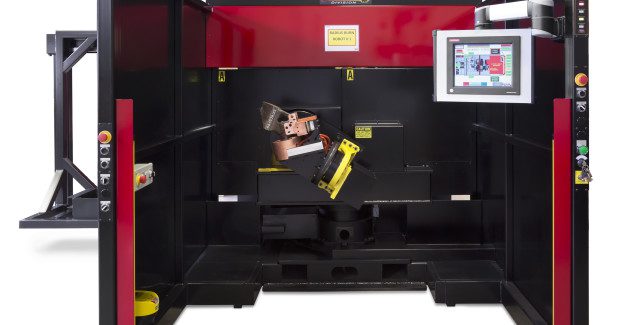Robotic Welding Productivity: Touch and Go
The interaction between the operator and a robotic welding system can be improved by centralizing operations into one user interface.
Posted: May 20, 2014
The appeal of robotic welding has grown vastly for manufacturers with the advent of such convenient options as a simple, touchscreen palm station linked to the robotic pendant and a human machine interface (HMI), the user interface in a robotic welding system. No matter how advanced the system gets, manufacturers can easily increase work cell efficiency and productivity; thanks to the use of an HMI.
The human-machine interface is a simple graphical terminal that allows operators to control, monitor and collect data from the system, using a simple touchscreen on a hand-held device on the shop floor. It gives operators a realistic view of the robotic welding systems, from operating trends to productivity tracking. It also provides crucial alerts for troubleshooting should operational issues occur during the welding process. And, it can replace hundreds of push buttons, selectors, alarms, lights, and more on the equipment, providing palm-size control of the entire system, from the simplest of commands to the most complex.
Three standout benefits of an HMI option with robotic welding systems are as follows:
- Immediate notification of issues with overall operations, such as production down time and safety
- Increase productivity with full system utilization
- Efficient workforce and operator training
Using the HMI’s graphic-based visualization of the system, the operator can get a simplified look at operations. This helps reduce training time and improves the operator’s understanding of the overall system. And with industry advancements like the HMI, manufacturers can develop and maintain a truly technologically advanced facility.
By implementing this technology, operators will have everything required for success with the system – robot programming, cell layout, safety devices and machine tools. The cell’s operation can be enhanced by using the combination of process control variables and measurements. With its uniform appearance and real-time updates, the user interface also can provide clear identification of correct operations and system errors.
The HMI acts as the single point of information for the robotic welding system, fully enabling it to deliver increased output and operational productivity. The HMI enhances interaction with multiple devices and operations – robotic articulation and procedure, auxiliary axis and rotary table, part manipulators, tool changers and other devices.
A major benefit of HMI screens is the ability to display errors to the operator. In a robotic welding system with tooling, the part movement, handling and welding can become quite complicated. A system of this nature may have an estimated 100 sensors on each tool; so implementing a HMI is an effective way of handling errors and operations. The incorporation of advanced data collection and monitoring can improve operation and functionality of an advanced robotic system. HMIs provide the operator with the ability to control and monitor this data from the robotic welding system, through advanced design techniques that allow users to identify, diagnose and correct system operations.
An intuitive interface design also will reduce training time for the operator – another inherent efficiency of an HMI system. What’s more, this evolution in robotic welding offers the ability to draw in the next generation of manufacturing workforce, which has grown up on digital and wireless technologies. Their familiarity and comfort with the user interface design ensures ease of implementation on the manufacturing floor.
The use of HMI in robotic welding operations delivers notable benefits for manufacturers. From its user-friendly, graphical interface to its capacity to capture valuable real-time operating and production data, all available through a simple touchscreen interface, HMIs ultimately can yield time and cost savings and a profitable, continuous production on the shop floor.












